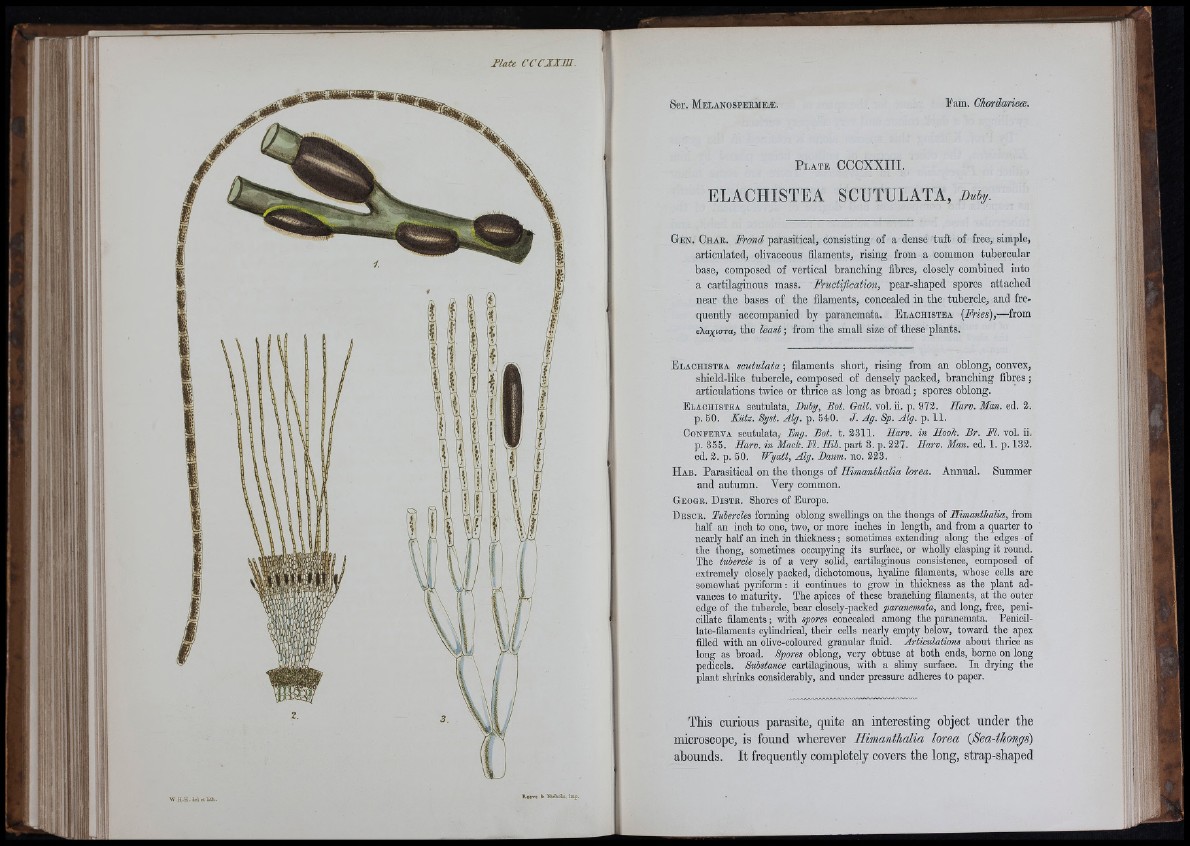
P l a t e CCCXXIII.
ELACHISTEA SCUTULATA, Duby.
Gén. C h a r . Frond p a r a s i t i c a l , c o n s i s t i n g o f a d e n s e t u f t o f f r e e , s im p l e ,
a r t i c u l a t e d , o l iv a c e o u s f i l a m e n t s , r i s i n g f r o m a c o m m o n t u b e r c u l a r
b a s e , c o m p o s e d o f v e r t i c a l b r a n c h i n g f ib r e s , c lo s e ly c o m b i n e d i n t o
a c a r t i l a g i n o u s m a s s . Fructification, p e a r - s h a p e d s p o r e s a t t a c h e d
n e a r t h e b a s e s o f t h e f i l a m e n t s , c o n c e a l e d i n t h e t u b e r c l e , a n d f r e q
u e n t l y a c c o m p a n i e d b y p a r a n e m a t a . E l a c h i s t e a {Fries),— f r o m
eXaxiara, t h e tca s t; f r o m t h e sm a l l s iz e o f t h e s e p l a n t s .
E l a c h i s t e a scutulata ; f i l a m e n t s s h o r t , r i s i n g f r o m a n o b l o n g , c o n v e x ,
s h i e l d - l i k e t u b e r c l e , c o m p o s e d o f d e n s e l y p a c k e d , b r a n c h i n g f ib r e s ;
a r t i c u l a t i o n s tw i c e o r t h r i c e a s l o n g a s b r o a d ; s p o r e s o b l o n g .
E l a c h i s t e a scutulata. Duly, Bot. Gall. vol. ii. p. 973. Harv. Man. ed. 3.
p. 50. Kiitz. Syst. Alg. p. 540. / . Ay. Sp. Alg. p. 11.
CoNEERTA scutulata, Eng. Bot. t. 3311. Harv. in Hook. Br. El. vol. ii.
p. 355. Harv. in Mack. El. Hib.-fast 3 . -p.221. Harv. Man. e à .l. p .\3 2 .
ed. 3. p. 50. Wyatt, Alg. Danm. no. 333.
H a b . P a r a s i t i c a l o n t h e t h o n g s o f Himanthalia lorea. A n n u a l . S u m m e r
a n d a u t u m n . V e r y c o m m o n .
G e o g r . D i s t r . Shores of Europe.
D e s c k . Tubercles forming oblong swellings on the thongs of Himanthalia, from
half an inch to one, two, or more inches in length, and from a quarter to
nearly half an inch in thickness ; sometimes extending along the edges of
the thong, sometimes occupying its surface, or wholly clasping it round.
The tubercle is of a very solid, cartilaginous consistence, composed of
extremely closely packed, dichotomous, hyaline filaments, whose cells are
somewhat pyriform : it continues to grow in thickness as the plant advances
to maturity. The apices of these branching filaments, at the outer
edge of the tubercle, bear closely-packed paranemata, and long, free, peni-
cUlate filaments ; with spores concealed among the paranemata. Penicil-
late-filaments cylindrical, their cells nearly empty below, toward the apex
filled with an olive-coloured granular fluid. Articulations about thrice as
long as broad. Spores oblong, very obtuse at both ends, borne on long
pedicels. Substance cartilaginous, with a slimy sm-face. l a drying the
plant shrinks considerably, and under pressm-e adheres to paper.
This curious parasite, quite an interesting object under the
microscope, is found wherever Himanthalia lorea {Sea-tkonys)
abounds. It frequently completely covers the long, strap-shaped
I
M b
■ Í
J